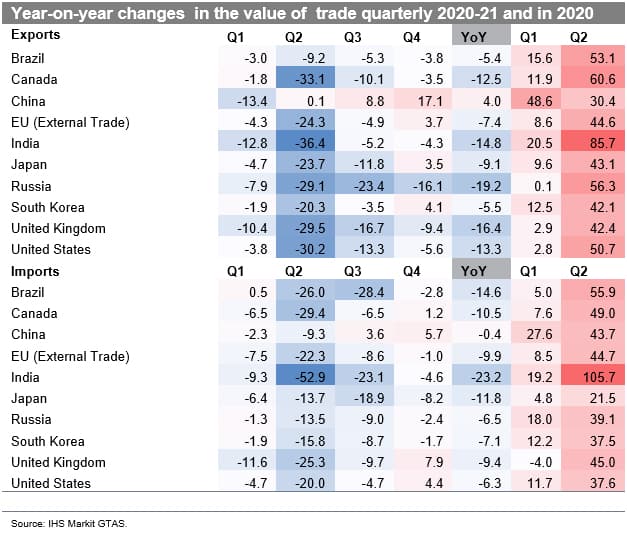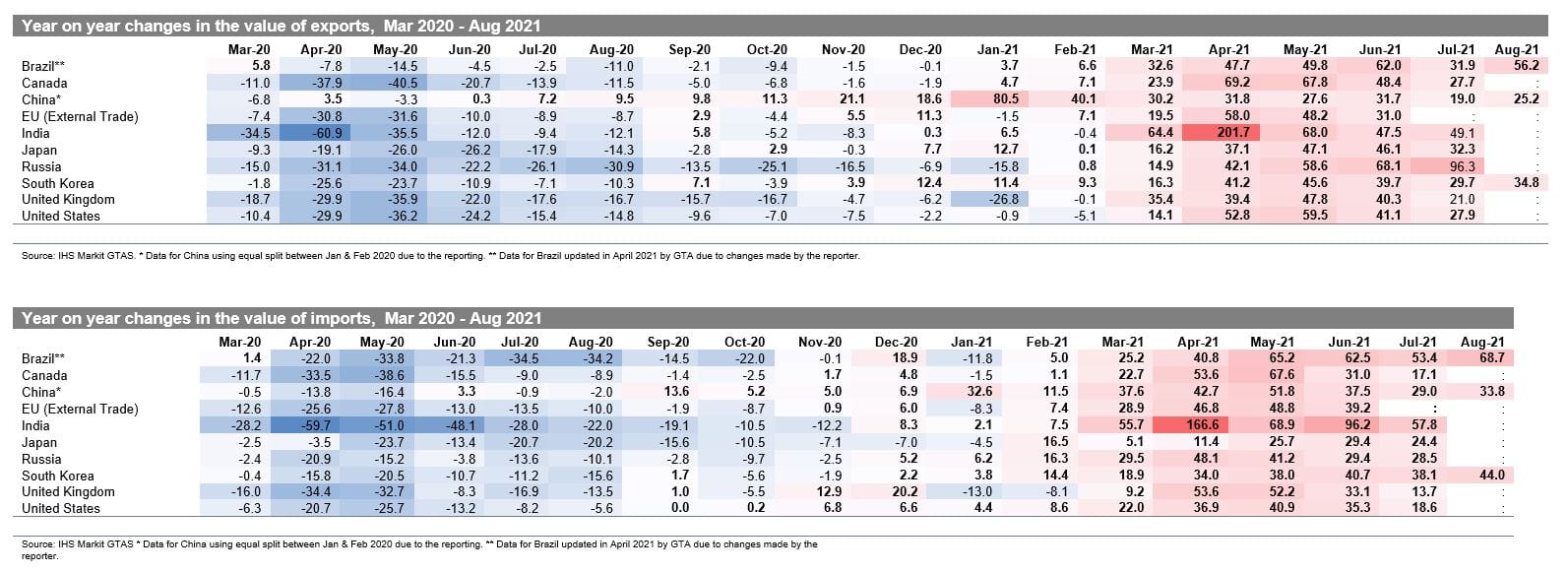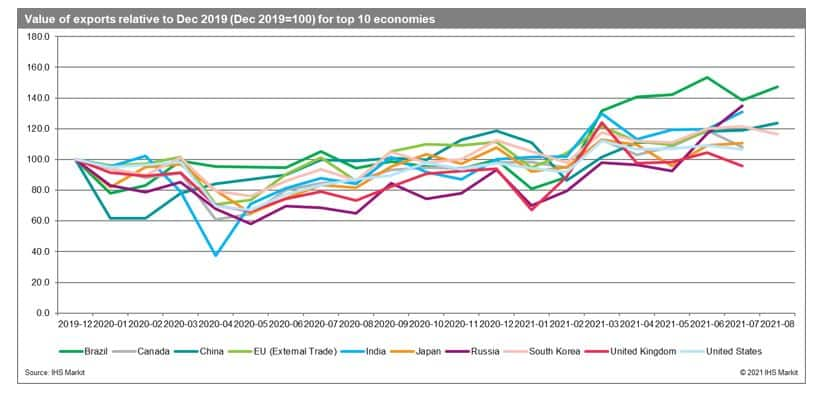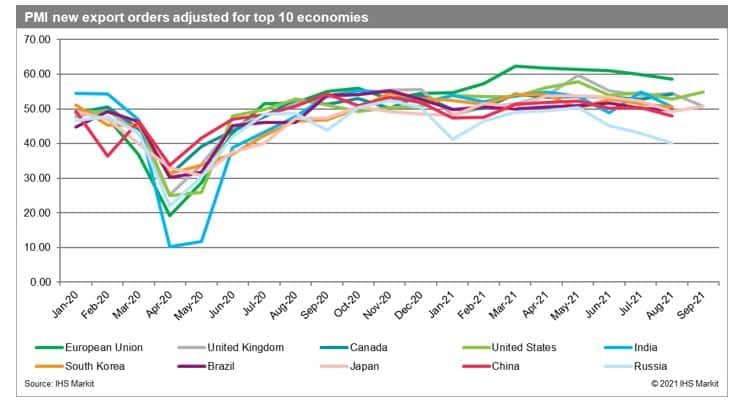Customer Logins
Obtain the data you need to make the most informed decisions by accessing our extensive portfolio of information, analytics, and expertise. Sign in to the product or service center of your choice.
Customer Logins
BLOG
Oct 01, 2021
With the peak of the recovery in Q2 2021, global trade is likely to grow more moderately in Q3 & Q4
This analytics article utilizes trade data published by IHS Markit Global Trade Atlas (GTA)
Key Observations
- The data on year-on-year (yoy) growth rates point to a sustained recovery in trade (both exports and imports) among the top 10 economies for some of the states already in Q4 2020, most of the states in Q1, and all the states under analysis in Q2 2021
- Exports are growing in all the top 10 states from March 2021 onwards, with the situation in the first two months of 2021 more nuanced; they reached a maximum around April - May this year (base effect) and are now in general lower; we expect more moderate growth rates in Q3 & Q4 of 2021
- In July 2021, all states reported export levels higher than in December 2019, apart from the UK; among the top 10, China recovered the fastest, although, in relative terms, Brazil reached the highest export levels, followed by Russia and India
- From a sectoral perspective, in comparison to Q1 2021, the situation in Q2 improved significantly in works of art, tin & articles of tin, vegetable textile fibers, rawhides, and skins, mineral fuels, aircraft, vehicles, cotton, and silk; in addition, nickel and base metal exports started growing yoy
- The adjusted PMI new exports orders readouts for the global manufacturing industry in August 2021 were above the benchmark value of 50.0 points (50.97) the 12th month in a row showing a sustained and positive short-term outlook for global trade; the values were, however, below of 50.0 for the first time in months for Brazil (49.70), Japan (49.30), China (47.95) and once again for Russia (40.18)
- PMI NExO in August 2021 for global manufacturing (50.97) is above of, and global services are below of (49.52) the 50.0 points; PMI NExO for global services fell for the second time in more than half a year and, the manufacturing PMI NEx0 decreased for the third time in a row, once again predicting more moderate growth rates in exports in the remainder of 2021
- In Q2 2021, real global GDP is estimated to have grown by 11.5%, with the growth impulse stronger for advanced (12.3%) than emerging economies (10.2%). The prospects for Q3 and Q4 according to IHS Markit global link model forecasts from September are positive, with growth rates moderating to 4.7% and 4.2% accordingly (and are lower in comparison to prior forecasts from August), with growth stronger overall in advanced economies (this should continue till Q2 of 2022)
Changes in Trade of the Top 10 Economies
- With data steadily incoming from the monthly reporters and included in the Global Trade Atlas (GTA), we are able to look at the complete two quarters of 2021 for all of the top ten economies
- The data on growth rates point to a sustained recovery in trade (both exports and imports) among the top 10 economies for some of the states already in Q4 2020, most of the states in Q1, and all the states under analysis in Q2 2021
- The fastest yoy grower in Q1 was China; in Q2, it was India, followed by Canada, Russia, Brazil, and the US
- In Q2, the reported growth rates in exports for most of the states are higher than in imports

- Exports are growing in all the top 10 states from March 2021 onwards, with the situation in the first two months of 2021 more nuanced; imports, in turn, started growing in all the states a month earlier (Feb 2021) apart from the UK, which showed negative growth rates both in January and February
- Generally speaking, the growth rates reported by the top 10 are the highest in the months most adversely affected by the pandemic itself in 2020 and the initial strict reactions of the affected states in 2020 (mainly January to May) and thus moderate to lower levels in the later months of Q2 2021 and forthcoming quarters (the base effect)
- The highest yoy growth rates were observed in India in April 2021, both in exports (+201.7% yoy) and imports (+166.6% yoy), the country most adversely affected in April 2020; the base effect is thus apparent and has to be taken into account in the correct interpretation of the data
- Only three states have already reported data for August 2021 - Brazil (+56.2% yoy in exports), China (25.2%) & South Korea (34.8%); the growth rates are positive are strong but lower than observed in the preceding months (peak of the recovery), in line with our earlier expectations; the growth rates are at the same time, higher in imports than in exports - possibly indicating better customer expectations and thus stronger internal demand
- The growth rate of Chinese exports in July was the lowest since the beginning of the year - it picked up, however, in August; the same applies to Brazil and South Korea (growth rates higher in August than in July 2021); nonetheless, it seems that the period of elevated growth rates observed in trade is coming to a close, the confirmation of this thesis will come in the next two months
- On a positive note, Russia reported the highest increase in exports yoy in July 2021, despite PMI NExO below of 50.0 benchmark, that could be due to the structure of its specific exports based on crude oil, natural gas, and coal & coke exports

Source: IHS Markit Global Trade Atlas (© 2021 IHS Markit)
- If we compare the value of exports to the last month preceding the global pandemic, we see that in July 2021, all states reported export levels higher than in December 2019, apart from the UK; among the top 10, China recovered the fastest, although in relative terms, Brazil, reached the highest export levels, followed by Russia and India
- As to the shape of the Covid-19 crisis, it is clear by now that this resembles modified V - with the rapid decrease in Q1/Q2 2020 followed by a much more moderate recovery, flatter leg

Sectoral perspective
- This section looks at quarterly data for the top 10 economies exports at the HS two-digit commodities disaggregation level. In comparison to the prior report, we take into account the Q2 of 2021.
- The recovery in the top ten exports in Q2 2021 is present in nearly all the sectors except for made-up textiles and edible vegetables (negative yoy growth rates in Q2, the commodity group seems to behave counter-cyclically).

The full version Table with sectoral breakdown for all HS2 codes is available to our Global Trade Analytics Suite (GTAS) clients only on Connect platform. Contacts IHS Markit Customer Care Customer.Care@ihsmarkit.com for details
- In comparison to Q1 2021, the situation in Q2 improved significantly in works of art, tin & articles of tin, vegetable textile fibers, rawhides, and skins, mineral fuels, aircraft, vehicles, cotton, and silk; in addition, nickel and base metal exports started growing yoy
- In most sectors, recovery started already in Q3 2020, and then the number of recovering sectors increased from quarter to quarter.
- Overall, Q4 2020 brought a general recovery (+3.6% yoy), and Q1 2021 generated the foreseen boost to top 10 exports (+16.8% yoy), followed by even more impressive growth in Q2 2021 (+42.9% yoy). We expect the growth to be more moderated in yoy terms in Q3 & Q4 of 2021
Prospects for the Forthcoming Months
- Econometric analysis on monthly processed bilateral trade flows by the GTAS Forecasting team shows that COVID-19 still exerts an adverse impact on international trade flows; however, the effect is slowly diminishing in magnitude (it is observed both for new cases, new deaths, as well as COVID-19 monthly average of daily Oxford's Government Response Tracker on the stringency of response to the pandemic by individual states)
- The cumulative number of confirmed cases of COVID-19 globally by 26 September 2021 reached 231.4 (and is likely to get 250 million cases threshold by November 2021) and 4.74 million deaths
- The 2-week moving averages of global new cases globally started to decline by mid-August 2021, with global average death rates following with a two-week delay; it seems that the peak of thefourth wave is behind us, and the number of restrictions is subsiding; thus, the impact on global trade is weakening
- On a positive note, the higher number of cases seems not to lead, to a large extent, to an increase in a similar magnitude increase in the number of reported deaths
- The reported number of vaccinations globally reached 6.18 billion with 2.95 billion people fully vaccinated (with two doses or equivalent one dose), which is equal to 33.2% of the global population; to bust immunity, some countries, most advanced, started to distribute the third dose mostly among the population aged 50+
- The adjusted PMI new exports orders (PMI NExO) readouts for the global manufacturing industry in August 2021 were above the benchmark value of 50.0 points (52.72) the 12th month in a row showing a sustained and positive short-term outlook for global trade.
- The values for August were pointing to a positive short-term outlook for exports in six out of the top 10 economies with the highest values once again for the European Union (58.70), the United Kingdom (54.48), Canada (54.31), and the US (52.83); the values were below of 50.0 for the first time in months for Brazil (49.70), Japan (49.30), China (47.95) and once again for Russia (40.18) - 8th month in a row
- The readouts for September are by now available for the US (54.90), the UK (50.81), and Japan (50.72)
- PMI NExO in August 2021 for global manufacturing (50.97) is above of, and global services are below of (49.52) the 50.0 points; PMI NExO for global services fell for the second time in more than half a year and, the manufacturing PMI NEx0 decreased for the third time in a row

- The most recent real GDP growth forecasts from IHS Markit were published on 15 September 2021 and are based on the baseline scenario of the impact of COVID-19 on the global economy and rising global concerns over inflation and the presence of increasing once-again GVCs disruptions
- The now estimated contraction in real global GDP is -3.4% in 2020, varying between -4.5% for advanced, -1.6% for emerging, and -5.1% for the most affected developing economies
- We foresee a global recovery in 2021, with year-on-year real GDP growth rates predicted to reach 5.6%. The growth rates are expected to vary between 5.1% (4.1% in 2022) for advanced, 6.5% (5.1%) for emerging, and 4.1% (5.0%) for developing states
- Real global GDP contracted in every single quarter of 2020, with Q2 being the worst quarter
- The estimated growth rate in Q1 2021 was 3.4% and varied between -0.1% for advanced and 8.7% for emerging economies. In Q2 2021, real global GDP is estimated to have grown by 11.5%, with the growth impulse stronger for advanced (12.3%) than emerging economies (10.2%). The prospects for Q3 and Q4 are positive, with growth rates moderating to 4.7% and 4.2% (lowered in comparison to prior forecasts from August), with growth stronger overall in advanced economies (this should continue till Q2 of 2022)
- Apart from China (+18.3%), five other economies out of the top 10 group are now estimated to have grown in real terms in Q1 2021. These are Brazil (+2.3%), Canada (+0.3%), South Korea (+1.9%), India (+1.7%) and the US (+0.5%)
- All top 10 are estimated to grow in Q2 and remaining quarters of 2021-22, with the strongest growth impulse in Q2 2021 in the UK (+22.2%), Canada (+12.7%), the EU (+13.7%), Brazil (+12.4%) and the US (+12.2%); real GDP growth rates in Q3 & Q4 are forecasted to be positive but much more moderated, it seems, we are over the top of recovery in reported real GDP growth rates, similarly to data on trade; the fastest grower among the top ten in Q3 will be India (21.3%) and the UK (+6.8%) in Q4
This column is based on data from IHS Markit Maritime & Trade Global Trade Atlas (GTA) & GTAS Forecasting.
For more details about Global Trade Atlas Forecasting please visit the product page
https://ihsmarkit.com/products/gta-forecasting.html
For more details about Global Trade Atlas (GTA) please visit the product page
https://ihsmarkit.com/products/maritime-global-trade-atlas.html
The full version of this article is available on the Connect platform for IHS Markit clients with a subscription to GTA/GTA Forecasting or GTAS Suite.
*Please note that China (mainland) reported an aggregated value of trade for January-February 2020 - for the year 2020 the data in the GTA database were equally split between the two months. Brazil has revised data for 2020 affecting the reported growth rates.
{"items" : [
{"name":"share","enabled":true,"desc":"<strong>Share</strong>","mobdesc":"Share","options":[ {"name":"facebook","url":"https://www.facebook.com/sharer.php?u=http%3a%2f%2fstage.www.spglobal.com%2fmarketintelligence%2fen%2fmi%2fresearch-analysis%2fglobal-trade-is-likely-to-grow-more-moderately-in-Q3-and-Q4.html","enabled":true},{"name":"twitter","url":"https://twitter.com/intent/tweet?url=http%3a%2f%2fstage.www.spglobal.com%2fmarketintelligence%2fen%2fmi%2fresearch-analysis%2fglobal-trade-is-likely-to-grow-more-moderately-in-Q3-and-Q4.html&text=With+the+peak+of+the+recovery+in+Q2+2021%2c+global+trade+is+likely+to+grow+more+moderately+in+Q3+%26+Q4+%7c+S%26P+Global+","enabled":true},{"name":"linkedin","url":"https://www.linkedin.com/sharing/share-offsite/?url=http%3a%2f%2fstage.www.spglobal.com%2fmarketintelligence%2fen%2fmi%2fresearch-analysis%2fglobal-trade-is-likely-to-grow-more-moderately-in-Q3-and-Q4.html","enabled":true},{"name":"email","url":"?subject=With the peak of the recovery in Q2 2021, global trade is likely to grow more moderately in Q3 & Q4 | S&P Global &body=http%3a%2f%2fstage.www.spglobal.com%2fmarketintelligence%2fen%2fmi%2fresearch-analysis%2fglobal-trade-is-likely-to-grow-more-moderately-in-Q3-and-Q4.html","enabled":true},{"name":"whatsapp","url":"https://api.whatsapp.com/send?text=With+the+peak+of+the+recovery+in+Q2+2021%2c+global+trade+is+likely+to+grow+more+moderately+in+Q3+%26+Q4+%7c+S%26P+Global+ http%3a%2f%2fstage.www.spglobal.com%2fmarketintelligence%2fen%2fmi%2fresearch-analysis%2fglobal-trade-is-likely-to-grow-more-moderately-in-Q3-and-Q4.html","enabled":true}]}, {"name":"rtt","enabled":true,"mobdesc":"Top"}
]}




